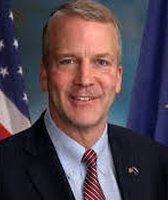Stand up for the facts!
Our only agenda is to publish the truth so you can be an informed participant in democracy.
We need your help.
I would like to contribute

Was Will Weatherford, center, correct that we spend more on health care for the dying than education for the young? (Tampa Bay Times photo)
Florida State House Speaker Will Weatherford called for an increased focus on education in Florida and the country in a speech to young professionals on Aug. 28, 2013. To drive his point home, he cited twice what seems like a simple, punchy statistic: "As a society, we spend more money on people's health care in the last six or 12 months of their life than we spend in the first 18 years of their life educating them."
When Weatherford followed up his claim the second time around by adding that he wasn’t positive about the details, PolitiFact couldn’t resist the open invitation to look for them.
When we sought out Weatherford’s proof, spokesman Ryan Duffy told us he didn’t have much, since it wasn’t part of the speaker’s prepared remarks. Eventually, we received an unofficial account of government spending with health care and education dollar amounts highlighted.
After more reporting on our part, a closer look at the original statement revealed a lot of murkiness and a comparison that isn’t all that easy to pin down.
"It’s a little bit like comparing apples and parakeets," said Jay Wolfson, a health law professor at University of South Florida.
Sifting through health care costs
Not every person who dies is elderly, of course, but from the contrast Weatherford uses, it’s clear his focus was on comparing children with seniors.
The two most obvious sources for health care spending on the elderly are Medicare and Medicaid. Most seniors get Medicare, and the poorest also qualify for Medicaid. We found that at least 80 percent of seniors are on Medicare when they die.
A 2001 study using data from the mid 1990s found that the average Medicare cost over the last year of a patient’s life is $26,300, but Wolfson pointed out that though this finding is reliable, those numbers are old and Medicare represents only a part of the health care picture. That doesn’t necessarily mean that more comprehensive data is available, though.
Aside from Medicare and Medicaid, any private insurance costs must be factored in, as well as out-of-pocket spending, Wolfson said. Compiling all the relevant costs is difficult and something that he hasn’t seen done, he added.
His estimate for a more inclusive dollar amount would be about $90,000, but there’s no way to know for sure with the data available.
It’s also important to note that even if Weatherford did get his numbers right, it’s hard to assume the money is wasted or misallocated, said Diane Meier, director of the Center to Advance Palliative Care. His statement "suggests somehow we know these people are in their last year of life, and we’re just throwing money hand and fist out the window," Meier said. "Very appropriately, that’s when they need and receive medical care."
Any broad statement about health care costs should raise red flags due to a difficulty in pinpointing solid data, said Gail Wilensky, a health care economist with Project HOPE who formerly directed the Medicare and Medicaid programs.
"When people make these cavalier statements, you just ought to roll your eyes, unless you can get them to give you their data sources," she said.
The cost of making the grade
It’s clear that the health care numbers are difficult to pin down, but what about the education part of his claim?
When we look at elementary and secondary education, we’ll focus on the public, state-funded numbers. But we should note that Weatherford used the word "society," which sounds all-inclusive, as if we should be tabulating our average costs from funds both public and private, from local municipalities, the state of Florida and the federal government.
The Florida Department of Education doesn’t have easily accessible data that goes back 13 years, so we’ll use the most recent year of data as the starting point.
For the 2010-11 school year, the median spending in Florida per pupil was $9,948, according to a National Center for Education Statistics report. In order to simulate what K-12 spending would look like, let’s multiply that number by 13, to represent the number of school years from kindergarten through 12th grade. We get $129,324.
Using $129,324 is an imperfect calculation, because that assumes that both the value of the dollar and the state budget have stayed the same since the class of 2011 entered kindergarten.
There’s also a method of calculating cost per student in Florida using the number of full-time-equivalent, or FTE students, which can be weighted based on special needs students and other more costly programs. The unweighted value is $6,786.68, which encompasses local and state operating expenditures divided by the number of students, according to University of Florida education policy professor Craig Wood. That number multiplied by 13 is $88,226.
Comparing health and education
Weatherford compared health care costs with education costs in order to make a larger point about a need for an increased focus on education. Using very rough numbers for both figures, we found it’s possible that K-12 education per student could cost more than end-of-life care per patient. The reverse is also a possibility.
Experts on both issues said they don’t have enough data to give definitive conclusions. In the absence of surefire evidence, we won’t rate Weatherford’s claim on our Truth-O-Meter.
Our Sources
Email interview with Craig Wood, University of Florida education policy professor, Sept. 3, 2013
HealthAffairs, "Medicare Beneficiaries’ Costs of Care in the Last Year of Life," 2001
National Center for Education Statistics, "Revenues and Expenditures for Public Elementary and Secondary School Districts: School Year 2010-11 (Fiscal Year 2011)," Sept. 2013
Phone interview with Cheryl Etters, Florida Department of Education press secretary, Sept. 6, 2013
Phone interview with Diane Meier, director of the Center to Advance Palliative Care, Sept. 6, 2013
Phone interview with Gail Wilensky, Project HOPE economist and senior fellow, Sept. 6, 2013
Phone and email interviews with Ryan Duffy, spokesman for Will Weatherford, Sept. 4, 2013
Phone and email interviews with Jay Wolfson, University of Southern Florida health law professor, Aug. 30, 2013
The Wall Street Journal, "The Crushing Cost of Care," July 6, 2012

















































